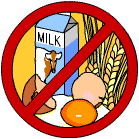Food Labels
Created | Updated Sep 2, 2009

There are some things that make people angry. Food labelling tends to be one of these. We're not talking about good or bad food labelling here, whatever those categories might mean. It's as if the very idea of food with labels on it causes otherwise normal people to become apoplectic.
Modern food comes with a user's manual, and a string of disclaimers that would make Pilate uneasy. The amount of information even goes some way towards justifying the amount of packaging, but not all that far, to be honest.
Some of the information is quite pretty, particularly those new traffic-light thingies, though it's not really necessary any more, ever since supermarkets discovered that putting everything inside insipid-looking pastel-shaded cardboard sleeves made it all much healthier.
The next most unnecessary information is the dates they print on things. The basic idea here is quite good, but they just don't tell us the important dates. For example, a 'Best Before' date is a bit irrelevant to people who eat food that's never been good anyway. An 'Acute Toxicity' date would be a lot more useful, because it would put the consumer in proper control of his life-choices. This could be backed up by an 'Inform Porton Down' date to make sure there aren't too many people who really let things slide.
There's a lot of stuff on there that amounts to some sort of quota system, but it's all way too complicated. Apparently you're supposed to eat five things a day that your dog wouldn't. If you're not careful, you might consume in a single meal the recommended amount of something-or-other that you should only need to buy once a fortnight in Boots.
There are cooking instructions on there too, but they generally just say that you ought to make sure everything is served scalding hot. Don't buy a fan oven either, because the food manufactures clearly have no idea what the temperature setting should be. Then there are the symbols that tell you that you shouldn't have frozen this, or alternatively that with a freezer as feeble as yours you should have thrown it away months ago.
Some food is apparently the produce of more than one country, which is surely just showing off. In a similar vein, they sometimes tell you that it might contain nuts. This is just to make the foodstuff seem more exotic, and it's a deeply cynical piece of marketing. If they had any real intention of making it exotic, there'd be no 'might' about it.
The weight of the goods is in units that you don't understand. In fact you don't understand them so comprehensively that they'll probably turn out to be the volume. They sometimes put a suspicious-looking 'e' around here somewhere, in a reprehensible attempt to make it look like foreigners are responsible.
Once they've established that you don't know how much of the stuff you're buying, they know they've got you. You're just going to roll over and die when it comes to the price. It's on there somewhere, only in a form that a computer can read but you can't. It's an endearing trait of the British that they'll put up with this sort of thing as long as the Queen's face is on the money they shell out. The Queen's on some of the produce too, but there's less and less 'by Appointment' in evidence these days. It's almost as if Her Royal Highness wouldn't be seen dead in Sainsbury's.
Brand-names are often surprisingly discreet among all this other guff. Those posh supermarkets that attract a serene tide of ageless ladies driving 4x4s positively thrive on understated branding. The next tier of food retailers have to be a little more brash, but they still eschew large lettering in bold colours for fear of attracting wobbly people in shell suits. Restraint is good for sales. Obesity is the new taboo, and selling smaller portions for the same price is the smart business response. Don't you dare ask for a carrier bag, either. The latest mantra is always a new way to provide less and pocket the saved costs, and it's an easy game when public conscience about insatiable consumption convinces us that we don't deserve what we're paying for.
And that's just about it for the labelling, except for the part that identifies the package contents. It must be here somewhere. We muddle through even though we struggle to find it. Only those among us who consort with internet grocers know the anguish of setting out to buy tinned pineapple and unpacking baked beans.
Labels. Who needs them? Sad to say, we all do, and not for information, but for some strange kind of reassurance. The produce that we eat sustains without satisfaction. If we can't have taste, we need some other sensory signal to log the experience. Recognition of appearance is the best we can manage, it seems, but it isn't enough. Deep inside, and in spite of the advertisers' siren messages, we know it isn't enough. No wonder then that food labels make our hackles rise, yours and mine.
